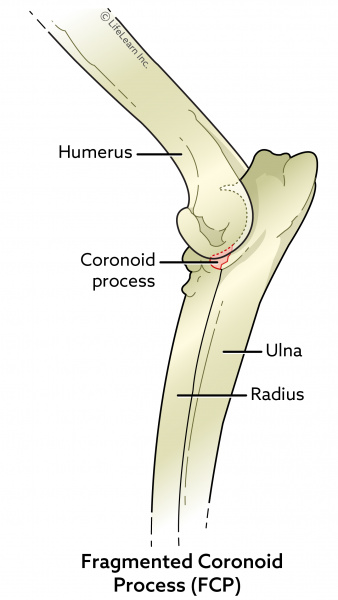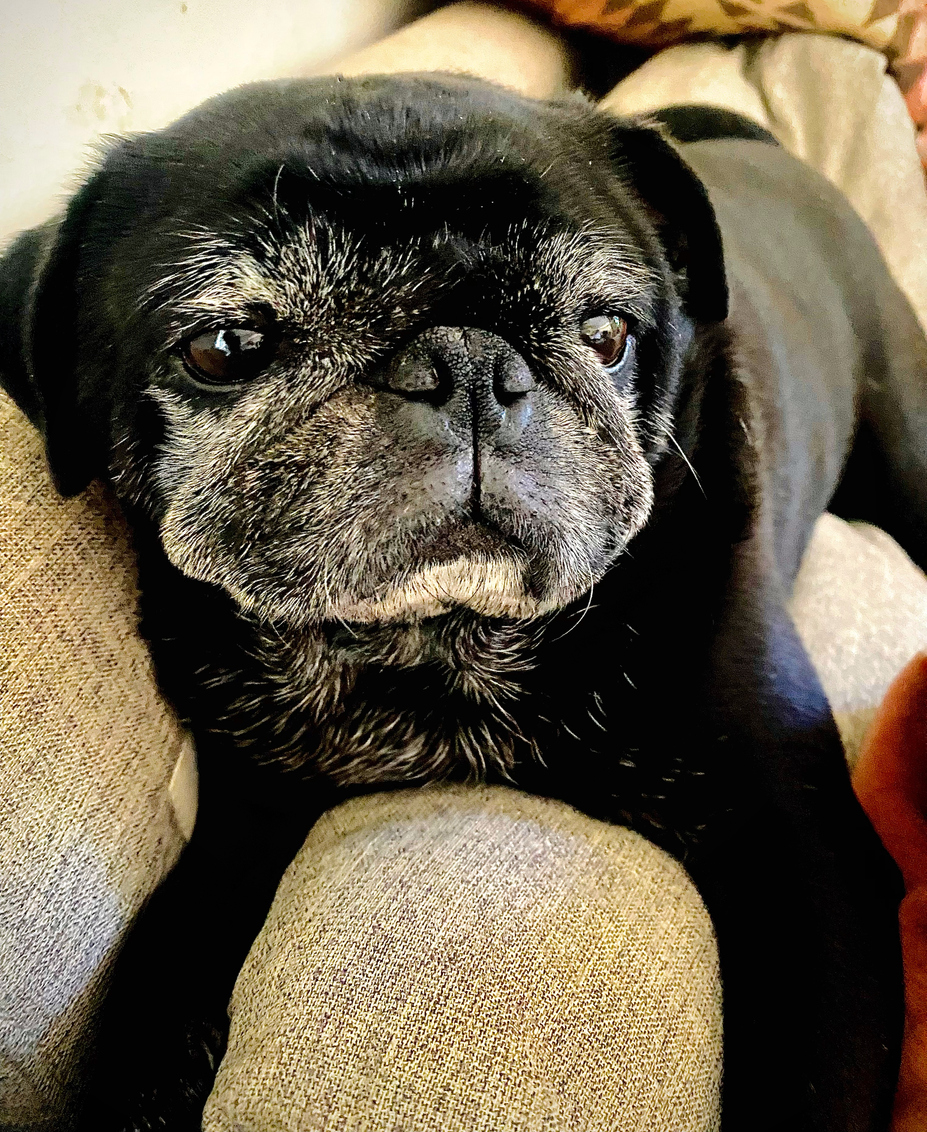Fragmented Coronoid Process
What is Fragmented Coronoid Process (FCP) in Dogs?
The elbow joint is made up of 3 separate bones, the radius, the ulna, and the humerus. Developmental abnormalities may occur in the elbow joint, mostly in medium and large breed dogs. There are three common developmental problems that are often referred to as elbow dysplasia, namely a fragmented coronoid process (FCP), and ununited anconeal process (UAP), and osteochondritis dissecans (OCD).
Dogs with elbow dysplasia typically have only one of the three conditions, and it is rare for a single dog to have all three components of elbow dysplasia.
This handout will cover the developmental abnormality known as Fragmented Coronoid Process.
What causes fragmented coronoid process?
Fragmented coronoid process (FCP) is a developmental defect of one of the coronoid processes, two small bony protrusions on the end of the ulna within the elbow joint. In this condition, one of the coronoid processes develops a fissure or crack and separates from the rest of the bone. It most commonly occurs on the inner, or medial, process. This separation causes pain and joint instability.Is this condition hereditary?
A genetic component is thought to be involved and males appear to be more commonly affected. The problem is usually seen in large breed dogs such as Bernese Mountain Dogs, Golden Retrievers, Labrador Retrievers, Rottweilers, and German Shepherds. Other factors involved in the development of elbow dysplasia may include nutritional imbalances (excesses or deficiencies), growth disorders, hormonal influences, and trauma.What are the sings of FCP?
With this condition, lameness usually develops in the front leg (foreleg) of young dogs that are between 5 and 11 months of age. The dog will have a mild to moderate weight-bearing lameness. Dogs with this disease are lame on the affected leg or legs and they may cry when the elbow is palpated (felt and manipulated). In many cases, the affected joint will be swollen and warm to the touch. The elbow joint will have a decreased range of motion, or decreased mobility, on an orthopedic examination. It is relatively common for the condition to develop in both elbows, although it is usually worse on one side than the other.
How is FCP diagnosed?
Because of the possibility of permanent lameness, your veterinarian will recommend diagnostic testing, in the form of radiographs (X-rays) if any lameness lasts more than 2 weeks in a young, large breed dog. Several radiographs of each affected leg, with the leg in different positions, are necessary in order to get an accurate assessment of various bones and joints. In many cases, this will require a short-acting anesthetic or sedative in order to achieve the optimal positioning for diagnostic purposes. In dogs under 6-7 months of age, X-rays can be challenging to interpret due to the presence of growth plates. To reach the diagnosis, it may be necessary to have the X-rays examined by a veterinary radiologist.
In some cases, the FCP may not be seen on standard radiographs. Rather, secondary signs associated with degenerative joint disease are seen. With FCP, a diagnosis may be made relatively early in the course of the condition using computerized tomography, or CT, scan).
What is the recommended treatment for FCP?
Surgery is the treatment of choice for this condition, and its aim is to remove any abnormal cartilage or bone in an attempt to return the joint to a more normal anatomy and function. The procedure may involve a surgical exploration of the joint or an arthroscopic repair. Arthroscopic repair may be the preferable technique because the smaller incision means that there is less damage done to the supporting structures (the joint capsule and ligaments). Your veterinarian may recommend referral to an orthopedic surgeon for this procedure.What is the prognosis with and without surgery?
If the joint is not treated surgically, degenerative changes will rapidly develop and the dog will suffer from chronic pain. Surgical treatment of FCP should be performed as soon as possible after diagnosis to minimize the development of degenerative joint disease.
In all cases, some degree of arthritis will develop in the elbow joint, but with surgical treatment, the arthritis will usually be less severe and there will be less pain involved. Medical treatment such as joint protective supplements and/or anti- inflammatory medications will usually be recommended to delay progression of degenerative joint disease. Proper weight management, as well as diets containing high levels of omega-3 fatty acids are also beneficial.
Will my dog need rehabilitation?
Rehabilitation is an important part of the post-operative care of the dog with FCP and is an important part of the medical management of this condition. In the immediate post-operative period, strict rest is required and anti-inflammatory and pain medication will be prescribed. You will be taught how to perform gentle massage and a type of exercise called passive range of motion (PROM) exercise. With this type of exercise, you will move the elbow joint gently through its normal range of motion while your dog is lying on its side, with no weight on the affected joint.
Depending on the specific case, a controlled low-impact exercise program will usually begin about 3 weeks after surgery. Until that time, the dog will require strict exercise restriction, and will only be allowed to go on short leash walks. Your veterinarian will provide you with specific instructions for the optimal rehabilitation program for your dog.
In all cases, it is important to maintain your dog's weight at an ideal level. Since this problem is caused by a developmental defect in the elbow joint, the joint will develop degenerative disease over time. The aim of treatment and rehabilitation is to minimize the degree of arthritis that develops, and to maintain a good quality of life for your dog.



